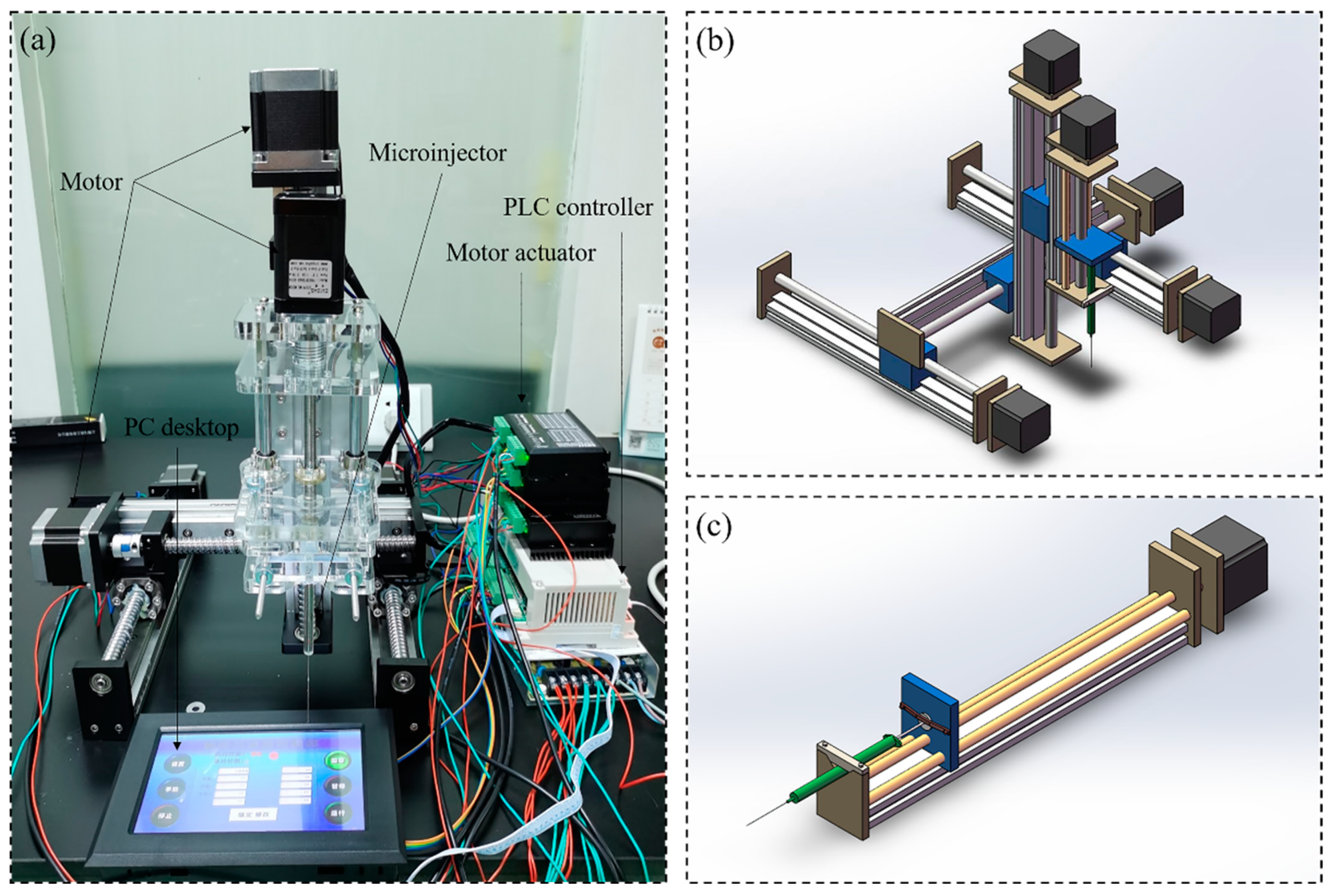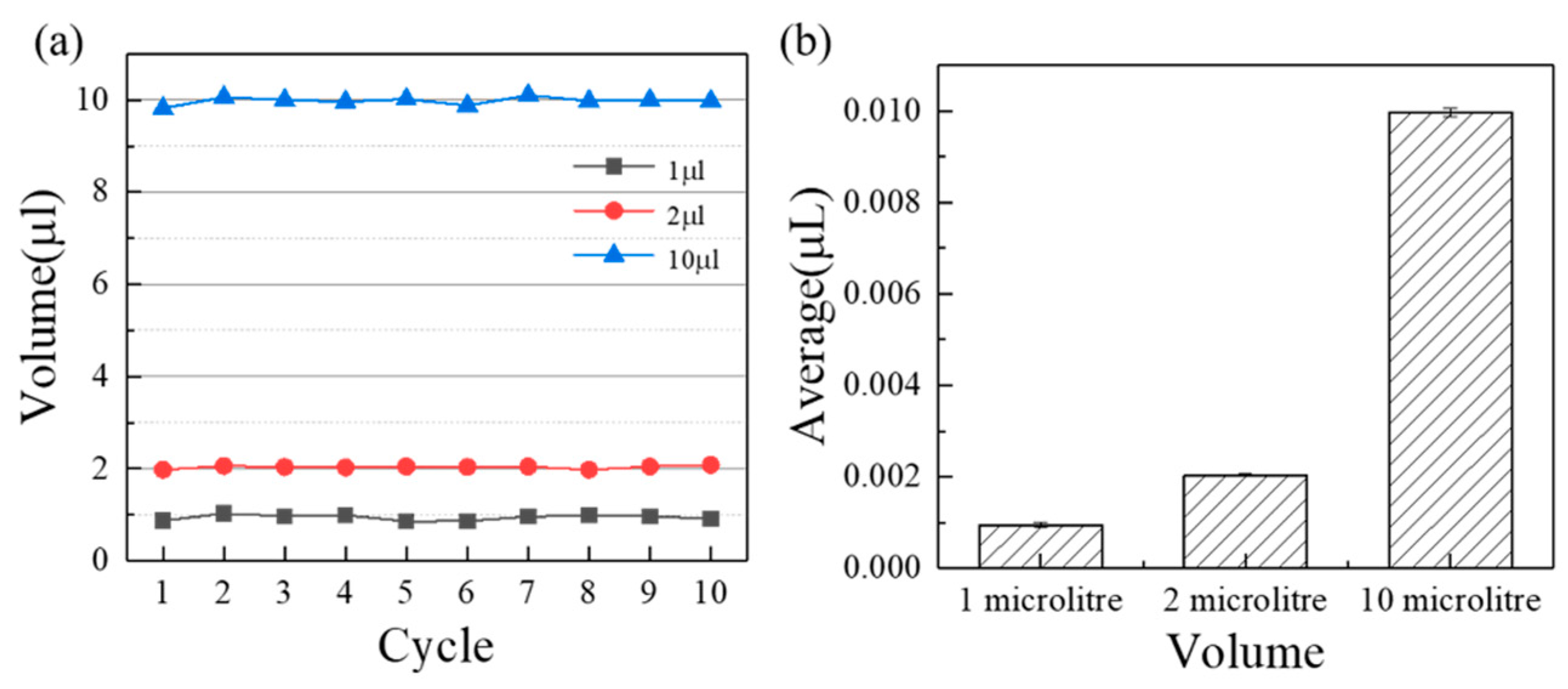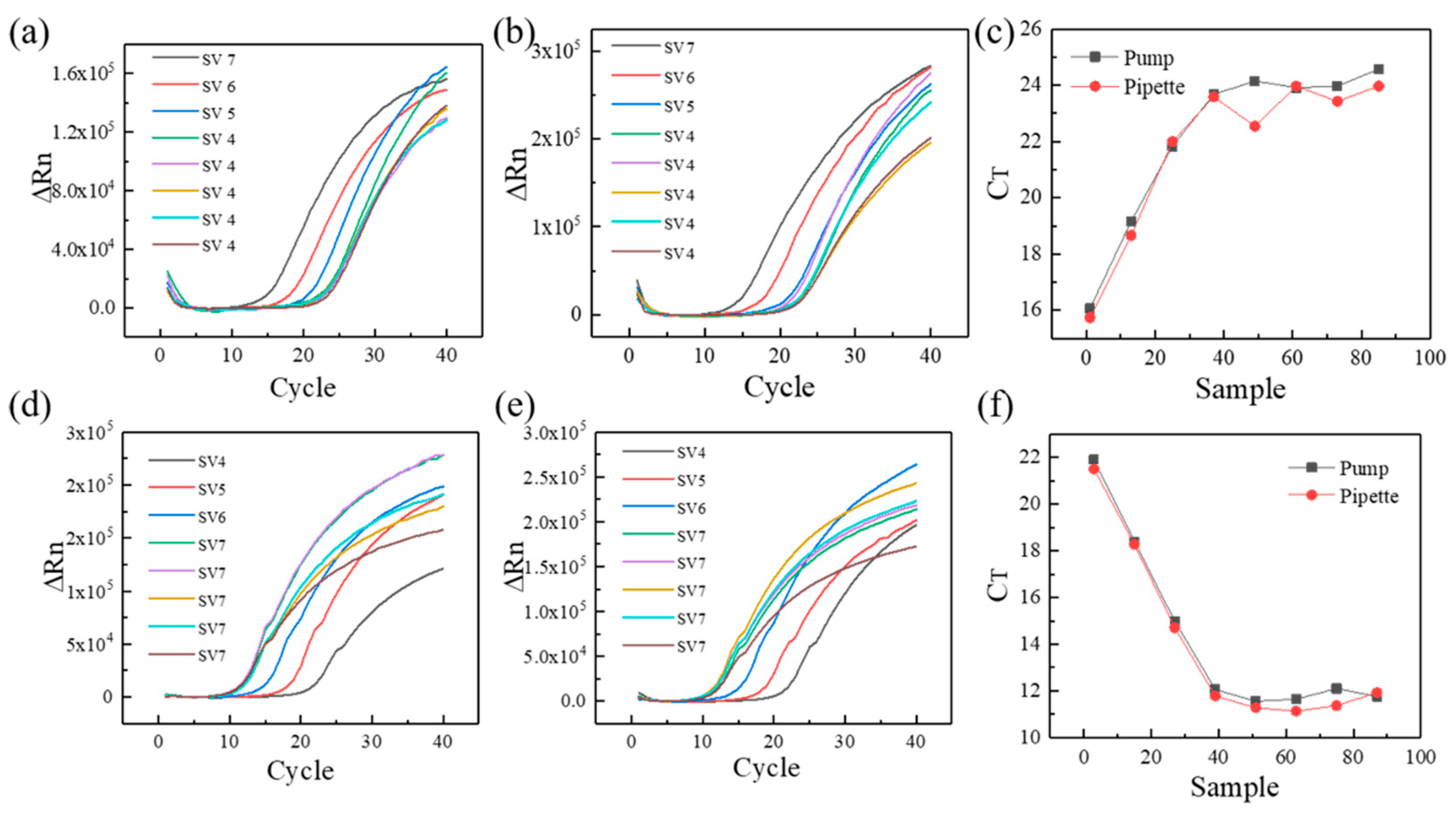Low Cost Three-Dimensional Programmed Mini-Pump Used in PCR
Abstract
:1. Introduction
2. Materials and Methods
2.1. Basic Composition
2.2. Accuracy Verification
2.3. PCR Verification
2.4. Statistics
3. Results and Discussion
3.1. Verification of Pipetting Accuracy by Weight Methods
3.2. Typical Application in Virus Detection with qPCR
4. Conclusions
- A custom-made three-dimensional programmed mini-pump was assembled with an accuracy of 0.2% for 10 , 1.8% for 2 and 5.6% for 1 .
- Relative to manual pipette, three-dimensional programmed mini-pump has a stronger reproducibility in PCR application (ORF1ab: 24.06 ± 0.33 vs. 23.50 ± 0.58, p = 0.1014; pGEM-3Zf (+): 11.83.06 ± 0.24 vs. 11.50 ± 0.34, p = 0.8779).
- The current programmed mini-pumpscan be realized with low cost.
Author Contributions
Funding
Conflicts of Interest
Appendix A. Supplementary Data
| Program Command= |
|---|
| >001: N1; |
| >002: Z-30; |
| >003: F2000; |
| >004: A-@1; |
| >005: F1200; |
| >006: L2000; |
| >007: Z+30; |
| >008:X+60; |
| >009: Z-30; |
| >010: F2000; |
| >011: A+@1; |
| >012: F1200; |
| >013: L2000; |
| >014: Z+30; |
| >015: X-60; |
| >016: N2=@2; |
| >017: END; |
References
- Humphrey, L.; Thommes, E.W.; Fields, R.; Coudeville, L.; Cojocaru, M.G. Large-scale frequent testing and tracing to supplement control of Covid-19 and vaccination rollout constrained by supply. Infect. Dis. Model. 2021, 1, 955–974. [Google Scholar] [CrossRef] [PubMed]
- Broeders, S.; Huber, I.; Grohmann, L.; Berben, G.; Taverniers, I.; Mazzara, M.; Roosens, N.; Morisset, D. Guidelines for validation of qualitative real-time pcr methods. Trends Food Sci. 2014, 37, 115–126. [Google Scholar] [CrossRef]
- Li, Y.M.; Jiang, Y.Y.; Wang, K.N.; Wu, W. Passive Micropump for Highly Stable, Long-Termed, and Large Volume of Droplet Generation/Transport Inside 3D Microchannels Capable of Surfactant-Free and Droplet-Based Thermocycled Reverse Transcription-Polymerase Chain Reactions Based on a Single Thermost. Anal. Chem. 2018, 90, 11925–11932. [Google Scholar] [CrossRef] [PubMed]
- Zhang, H.; Li, W.; Jin, M.; Zeng, J.; Yu, T.; Yang, D.; Xia, Y. Controlling the morphology of rhodium nanocrystals by manipulating the growth kinetics with a syringe pump. Nano Lett. 2011, 11, 898–903. [Google Scholar] [CrossRef] [PubMed]
- Wijnen, B.; Hunt, E.J.; Anzalone, G.C.; Pearce, J.M. Open-Source Syringe Pump Library. PLoS ONE 2014, 9, e107216. [Google Scholar] [CrossRef] [PubMed] [Green Version]
- Dey, N.; Mondal, U.; Sengupta, A. Adaptive Repetitive Control of Peristaltic Pump Flow Rate with an Optical Flow Sensing System; CRC Press: Boca Raton, FL, USA, 2021. [Google Scholar]
- Abe, T.; Oh-Hara, S.; Ukita, Y. Adoption of reinforcement learning for the intelligent control of a microfluidic peristaltic pump. Biomicrofluidics 2021, 15, 034101. [Google Scholar] [CrossRef] [PubMed]
- Vante, A.B.; Ramakrishnan, R. A Fluid-Structure Interaction Based Simulation Study Of Piezoelectric Micropump For Drug Delivery Application. IOP Conf. Ser. Mater. Sci. Eng. 2021, 1123, 012001. [Google Scholar] [CrossRef]
- Wu, X.; He, L.; Hou, Y.; Tian, X.; Zhao, X. Advances in passive check valve piezoelectric pumps. Sens. Actuators A Phys. 2021, 323, 112647. [Google Scholar] [CrossRef]
- Frdrich, C.; Renko, K.; Wiese, N.; Fischbach, A.; Seyffarth, C.; Neuenschwander, M.; von Kries, J.P.; Köhrle, J. A semi-automatic, non-radioactive 384-well high throughput screening DIO2 assay. Endocr. Abstr. 2021, 73. [Google Scholar] [CrossRef]
- Kumar, A.; Walia, V.; Mogili, S.; Fu, C.-C. Improved semi automatic approach to count the tracks on LR-115 film for monitoring of radioactive elements. Appl. Radiat. Isot. 2021, 176, 109863. [Google Scholar] [CrossRef]
- Panackal, A.A.; Tsui, F.C.; Mcmahon, J.; Wagner, M.M.; Dixon, B.W.; Zubieta, J.; Phelan, M.; Mirza, S.; Morgan, J.; Jernigan, D.; et al. Automatic electronic laboratory-based reporting of notifiable infectious diseases at a large health system. Emerg. Infect. Dis. 2002, 8, 685. [Google Scholar] [CrossRef] [PubMed]
- Kock, R.D.; Baselmans, M.; Scharnhorst, V.; Deiman, B. Sensitive detection and quantification of SARS-CoV-2 by multiplex droplet digital RT-PCR. Eur. J. Clin. Microbiol. Infect. Dis. 2021, 40, 807–813. [Google Scholar] [CrossRef]
- Dong, L.; Zhou, J.; Niu, C.; Wang, Q.; Fang, X.J.T. Highly accurate and sensitive diagnostic detection of SARS-CoV-2 by digital PCR-ScienceDirect. Talanta 2020, 224, 121726. [Google Scholar] [CrossRef] [PubMed]
- Luethy, P.M.; Kristie, J.J. Comparison of Three Sample-to-Answer RT–PCR Testing Platforms for the Detection of SARS-CoV-2 RNA in Positive Nasopharyngeal and Nasal Swabs. J. Appl. Lab. Med. 2021, 6, 1635–1639. [Google Scholar] [CrossRef]
- Takeshita, K. RT-PCR diagnosis of COVID-19 from exhaled breath condensate: A clinical study. J. Breath Res. 2021, 15, 037103. [Google Scholar]
- Rajabi, F.; Bakhshi, A.; Kazemi, G. Drug delivery applications of mechanical micropumps. In Proceedings of the International Conference on Applied Researches in Science & Engineering, Vienna, Austria, 19–21 February 2021. [Google Scholar]
- Peng, X.; Peng, L.; Guo, Y. A Highly Programmable Magnetic Micropump. Adv. Mater. Technol. 2021, 6, 2100150. [Google Scholar] [CrossRef]
- Uvarov, I.; Shlepakov, P.; Melenev, A.; Ma, K.; Krijnen, G.J.A. A Peristaltic Micropump Based on the Fast Electrochemical Actuator: Design, Fabrication, and Preliminary Testing. Actuators 2021, 10, 62. [Google Scholar] [CrossRef]
- Mcgenity, T.J.; Timmis, K.N.; Fernandez, B.N. Hydrocarbon and Lipid Microbiology Protocols; Springer Protocols Handbooks; Springer Nature: London, UK, 2016. [Google Scholar]
- Behrens, M.R.; Fuller, H.C.; Swist, E.R.; Wu, J.; Islam, M.M.; Long, Z.; Ruder, W.C.; Steward, R.J.S.R. Open-source, 3D-printed Peristaltic Pumps for Small Volume Point-of-Care Liquid Handling. Sci. Rep. 2020, 10, 1543. [Google Scholar] [CrossRef] [Green Version]
- Gao, R.Z.; Hébert, M.; Huissoon, J.; Ren, C.L. µPump: An Open-Source Pressure Pump for Precision Fluid Handling in Microfluidics. HardwareX 2020, 7, e00096. [Google Scholar] [CrossRef]
- Li, C.; Zhao, C.; Bao, J.; Tang, B.; Gu, B. Laboratory Diagnosis of Coronavirus Disease-2019 (COVID-19). Clin. Chim. Acta 2020, 510, 35–46. [Google Scholar] [CrossRef]
- Lippi, G.; Simundic, A.M.; Plebani, M. Potential preanalytical and analytical vulnerabilities in the laboratory diagnosis of coronavirus disease 2019 (COVID-19). Clin. Chem. Lab. Med. (CCLM) 2020, 58, 1070–1076. [Google Scholar] [CrossRef] [PubMed] [Green Version]




| ORF1ab | pGEM-3Zf (+) | |
|---|---|---|
| Forward | 5′ CCCTGTGGGTTTTACACTTAA 3′ | 5′ GGAGAGGCGGTTTGCGTATTGGG 3′ |
| Reverse | 5′ ACGATTGTGCATCAGCTGA 3′ | 5′ TTTGTGATGCTCGTCAGGGGGGC 3′ |
Publisher’s Note: MDPI stays neutral with regard to jurisdictional claims in published maps and institutional affiliations. |
© 2022 by the authors. Licensee MDPI, Basel, Switzerland. This article is an open access article distributed under the terms and conditions of the Creative Commons Attribution (CC BY) license (https://creativecommons.org/licenses/by/4.0/).
Share and Cite
Lin, C.; Wang, Y.; Huang, Z.; Guo, Y.; Wu, W. Low Cost Three-Dimensional Programmed Mini-Pump Used in PCR. Micromachines 2022, 13, 772. https://doi.org/10.3390/mi13050772
Lin C, Wang Y, Huang Z, Guo Y, Wu W. Low Cost Three-Dimensional Programmed Mini-Pump Used in PCR. Micromachines. 2022; 13(5):772. https://doi.org/10.3390/mi13050772
Chicago/Turabian StyleLin, Chengxiong, Yaocheng Wang, Zhengyu Huang, Yu Guo, and Wenming Wu. 2022. "Low Cost Three-Dimensional Programmed Mini-Pump Used in PCR" Micromachines 13, no. 5: 772. https://doi.org/10.3390/mi13050772
APA StyleLin, C., Wang, Y., Huang, Z., Guo, Y., & Wu, W. (2022). Low Cost Three-Dimensional Programmed Mini-Pump Used in PCR. Micromachines, 13(5), 772. https://doi.org/10.3390/mi13050772







